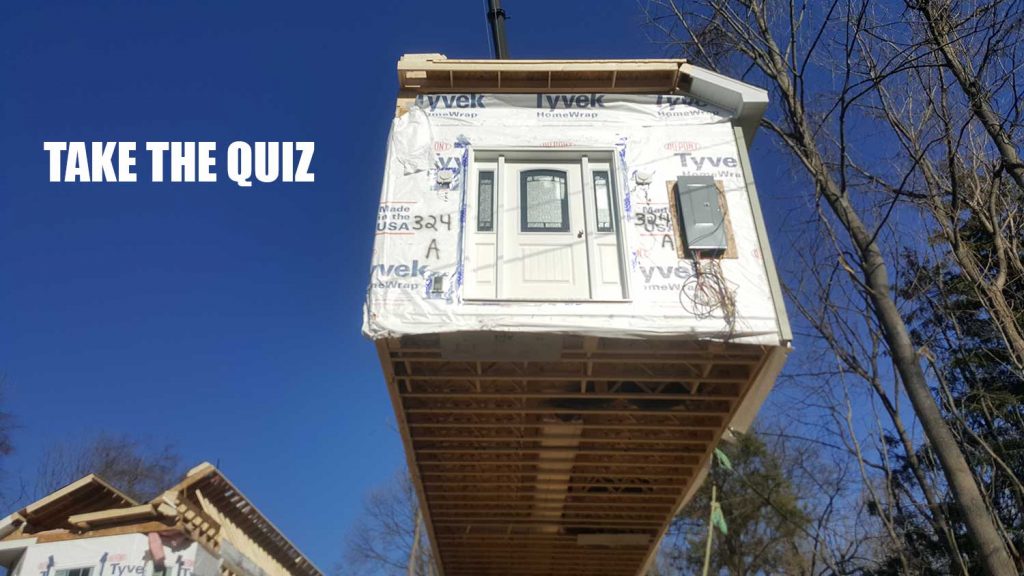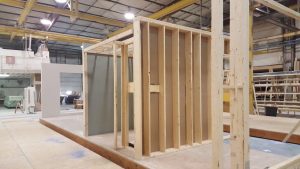Off-site Construction – Are you in the Know? Take this Quiz to Find Out!


Off-site construction is in the news! For residential construction, you may hear terms like modular, prefabricated, panelized, ICF’s, etc. The need to find a better way to build is being driven by severe labor shortages in the construction industry, a housing affordability crisis, and a lack of new home availability in the market. Off-site construction offers an opportunity to address all of these issues. The U.S. home construction industry is in transition. It is transforming itself from residential construction methods that have been in place for almost 200 years to automated, manufacturing processes to build the next generation of homes. During this transition, there is lots of misinformation about what off-site construction really is. Take this quiz to see how much you know about the future of home building!
The Off-site Construction Quiz
Here are 10 questions to test how much you know about the future of home building. Check your answers with the ones at the bottom of the page to find out if you are an Off-Site Rock Star!
Question #1 – Prefabricated homes and modular homes are the same things?
True or False
Questions #2 – The National Association of Home Builders recognizes four types of Building Systems. They are:
a) Modular, Panelized, Concrete, and Log & Timber
b) Steel, Panelized, Concrete, and Modular
c) Panelized, Glass & Steel, Concrete, and Modular
d)Concrete, Modular, Glass & Steel, and Log & Timber
 Question #3 – Modular Homes are built with low quality products.
Question #3 – Modular Homes are built with low quality products.
True or False
Question #4 – A modular home is the same as a mobile home or manufactured home.
True or False
Question #5 – The quality of homes built using off-site construction is __________
a) the same as a home that is built onsite.
b) better than the same home built onsite.
c) not as good as a home that is built onsite.
d) None of the Above
Question #6 – A home built using off-site construction will appraise for as much as a home built onsite.
True or False
Question #7 – A modular home can be finished in the factory up to ___% complete.
a) 65
b) 75
c) 85
d) 95
Question #8 – Which of the following is a typical type of panelized building system:
a) Open Panel
b) Closed Panel
c) Structural Insulated Panel (SIPs)
d) All of the Above
Question #9 – Off-site construction offers many benefits to home building. Which of the following isn’t one of them:
a) Produces less waste
b) Faster completion time
c) Safer for workers
d) Costs 50% less than building on site
Question #10 – Homes built using off-site construction are limited to the boxy design.
True or False
The Answers to the Off-site Construction Quiz
Answer #1 – False – The short answer is that all modular homes are prefab homes but not all prefab homes are modular homes. A prefab home is a type of home that consists of several components, or units, which are built in a factory and are then assembled on site to construct a complete home. The word “prefab” was not actually coined by the industry as were terms such as modular homes, panelized home, concrete homes, or site-built homes. It was originally used as a composite term for panelized and modular building systems and is meant to refer to either one.
Answer #2 – A – The Building Systems Council within the NAHB recognizes Modular, Panelized, Concrete, and Log & Timber as four distinct building systems.
Answer #3 – False – Much of this goes back to the confusion between manufactured homes and modular homes. A manufactured home is designed to cost less to manufacture to make it available to more people as affordable housing. Modular homes are built using the exact same items as you would find in a home built onsite. Structurally, the home is even built to a higher standard than is built onsite. However, the exterior and interior products used are the same. Hardwood flooring, tile, and high quality cabinets are installed in modular homes the same as site built homes. Lighting and plumbing fixtures are the same name brands you would find at local lighting or kitchen and bath showroom.
Answer #4 – False – The confusion around this one issue has plagued the modular construction industry. The industry hasn’t done itself any favors by having each of these terms start with the same “M” letter and sound the same! The term “modular home” is somewhat of a misnomer. It is a home that is stick built, it is just built offsite in modules. Modular is technically a type of construction, not a type of home. A modular home follows the International Residential Code for construction of Single Family Homes. This is the same building code that site built homes are required to meet. The difference is that modular homes are built in a factory, delivered to a home site, and placed on a foundation.
Answer #5 – B – Homes built in a factory are not only inspected to meet building code, but they are also inspected for quality. Because the construction of so many homes is concentrated in one location, quality control systems are put in place and rigorously managed.
Answer #6 – True – Modular homes are built to the same code as homes built onsite. The only difference being is that the home plan was divided into modular, built off-site, and then delivered to the home site for installation on the foundation. Once the home is complete, there is no difference between the two. Unlike manufactured homes, there is no legal requirement to disclose how the home was built.
Answer #7 – A or B – This is kind of a trick question. The level of completion is dependent on many factors: option selection, home design, home size, etc. Generally, a modular home’s modules are considered about 65-75% complete in the factory. The remaining balance is completed in the field after the home is installed on a permanent foundation.
Answer #8 – D – Open, closed, and SIPs are all a type of panelized off-site building system. An open panel typically describes a framed panel covered in sheathing only. A closed panel is one that typically has at least has the framing, the exterior sheathing, the interior sheathing/drywall, and will have electrical wiring installed (or at least chases for wiring). Windows and doors may also be pre-installed with closed panel construction. Structural Insulated Panels (SIPs) are a sandwich usually consisting of a foam core between a structural “skin”. The skin can be made up of wood, fiber, or any material that is tested and provides structural strength to the assembled panel.
Answer #9 – D – Off-site construction, particularly modular construction, does take advantage of some economies that can make it somewhat more cost effective. Factories can take advantage of items such as higher buying volumes, concentrated labor forces, and assembly-line construction. Overall savings for a modular home are typically 5-10%. While this makes modular homes a great value, it’s not a 50% savings.
Answer #10 – False – Today’s modern modular factories have the ability to build and deliver homes in virtually any style. Modern construction materials such as Laminated Veneer Lumber (LVL), floor trusses, roof trusses, and even the sophistication of Computer-aided Design (CAD) systems are propelling modular design to the forefront of the building world. Panelization, either by itself or teamed with modular construction, can deliver homes of any shape, style or size. There are very homes that can’t be provided using some form of off-site construction.
How Did You Do?
Home buyers and construction industry participants, from contractor to inspectors to real estate agent, are learning the facts about off-site construction. With labor constraints that are only growing in the construction industry, homes that start in a factory are finding their way into the mainstream of construction. The Internet provides the ability to put the miss-information about off-site construction to rest. The public is getting more educated and doing their research. Off-site construction is positioned to be the new way homes are built going forward!
The post Off-site Construction – Are you in the Know? Take this Quiz to Find Out! appeared first on Impresa Modular.




